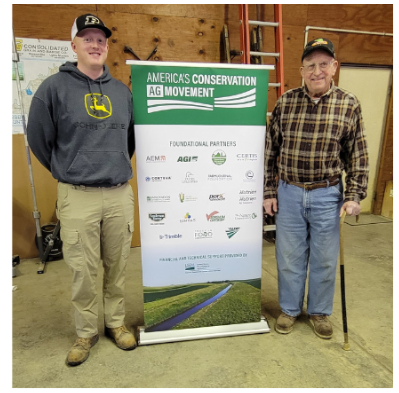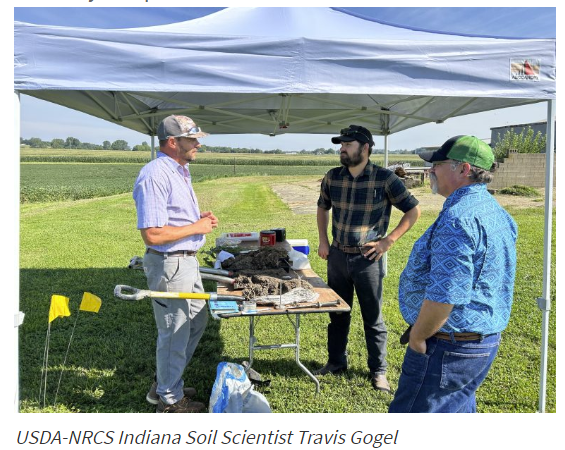Growers Who Rely Upon Cover Crops Say Diversity is Key to Maximum Soil Health Benefit

This article was written by Jamie Sears Rawlings with Trust In Food.
Eighty percent of U.S. growers who participated in the 2022-23 National Cover Crop Survey report that they used cover crops on their farms. That number overwhelms the national average (only 7.5 percent of U.S. farms in the 2017 Census), but it’s enough to signal that adoption of cover crops is rising.
For these new adopters, however, the learning curve is coming with some challenges along the way.
What if one cover crop works one year and not the next? How do you know when to terminate? Does planting green make sense?
Cover Crop Options Available For Every Farm

Indiana farmer Aaron Krueger told the almost 80 people in attendance that his soil health and organic material has grown as his cover crop diversity has grown. (Left: Aaron and Ronald Krueger of Krueger Farms in Owensville, Ind.)
“Wheat is a good starter program for a cover crop, but it likes to put on roots when it flowers, which is problematic,” Krueger said. “My advice is to look beyond just wheat into rye and a mixture.”
Like most growers, Krueger says he experiments with his cover crop mix, but mostly chooses to stay with a grass, legume, and brassica trident. His preferred mix ahead of corn includes four total legumes because they are easy to plant into, making it easy to plant into green, which is important on his farm.
Peas as his main legume, Krueger says, work well because peas produce a lot of biomass that is easily digestible.
Slow-Release Nutrients Feed Soil
Krueger was joined by fellow Indiana grower Cameron Mills, owner of Mills Family Farms. His cover crop mixture, he told the group, is designed intentionally to release nutrients that feed his soil throughout the growing season.
“Our cover crops have different carbon/nitrogen ratios and I want to make sure I have a slow-release of those nutrients over time,” Mills said. Using this method, he said, has allowed him to reduce his nitrogen use for the year to only 120 units. “Our goal with cover crops is to feed our biology,” he added.
Travis Gogel, Southwest Indiana Soil Scientist with USDA-NRCS, was on-hand at the event and shared that cover crops are integral, no matter the time in the growing season.

This consistent cover cropping is the method that Krueger uses, and he said it has provided him many benefits.
“Since we’ve started using more peas and vetch in our cover crop mix, we’ve been weaning our nitrogen use back,” he says. “And we aren’t using as many herbicides and fungicides because keeping your soil covered helps to suppress disease.”
Be Open To Experimentation
Mills cautioned that experimentation is equally as critical when cover cropping.
“Every year it’s different,” he said. “If you are waiting for your cover crops to get to the same biomass every year, you might be in trouble.”
After several years of consistent cover cropping, both Mills and Krueger believe in the practice’s benefits for soil health, building resilience and boosting profitability.
“Everyone can do it,” Mills said. “You just have to figure out your program.”
Krueger Farms hosted the field day in partnership with America’s Conservation Ag Movement, which works with innovative producers to share real-field results of agronomic practices that optimize soil health, improve water infiltration and storage, reduce inputs and other benefits that boost yields and ROI. Learn more by visiting www.americasconservationagmovement.com.
Feed Your Soil With Cover Crops







